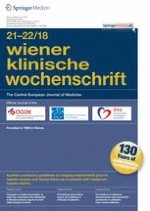Introduction
Methods
Ethical considerations
Sample
Sociodemographic data
Questionnaires
Statistical methods
Results
Sociodemographic data
n
| 55 | ||
Sex, n (%) | Age (years), n (%) | ||
Male | 25 (45.5) | 31–50 | 9 (16.4) |
Female | 30 (54.5) | >50 | 46 (83.6) |
Education, n (%)
|
Smoker, n (%)
| ||
Compulsory | 4 (7.3) | Yes | 4 (7.3) |
Vocational | 22 (40) | Stopped smoking | 30 (54.5) |
Secondary | 15 (27.3) | Never smoked | 20 (36.4) |
University | 10 (18.2) | Missing | 1 (1.8) |
Missing | 4 (7.3) | ||
Housing situation, n (%) | Alcohol, n (%) | ||
Living alone | 10 (18.2) | Several times per week | 3 (5.5) |
Not living alone | 39 (70.9) | Once a week | 3 (5.5) |
Missing | 6 (10.9) | Less frequently | 16 (29.1) |
Financial situation, n (%)
| Never | 33 (60.0) | |
Very good | 3 (5.5) | ||
Good | 22 (40) | ||
Enough | 27 (49.1) | ||
Missing | 3 (5.5) | ||
Gender
Substance use patterns
Somatic diseases
Self-reported somatic and mental symptoms
n
| % | |
|---|---|---|
Pain | 37 | 67.3 |
Anorexia | 32 | 58.2 |
Constipation | 23 | 41.8 |
Nausea/vomiting | 22 | 40.0 |
Edema | 22 | 40.0 |
Anxiety | 20 | 36.4 |
Dyspnea | 20 | 36.4 |
Sleeplessness | 18 | 32.7 |
Depression | 12 | 21.8 |
Diarrhea | 9 | 16.4 |
Confusion | 4 | 7.3 |
PHQ-9 and brief-TEMPS-M
Correlation with temperament type | ||
|---|---|---|
r | p-value | |
Depression
| ||
Depressive | 0.55 | p < 0.001 |
Cyclothymic | 0.52 | p < 0.001 |
Hyperthymic | 0.10 | p = 0.501 |
Irritable | 0.13 | p = 0.366 |
Anxious | 0.32 | p = 0.027 |
Anxiety
| ||
Depressive | 0.43 | p = 0.002 |
Cyclothymic | 0.30 | p = 0.036 |
Hyperthymic | 0.16 | p = 0.272 |
Irritable | 0.02 | p = 0.904 |
Anxious | 0.16 | p = 0.271 |
